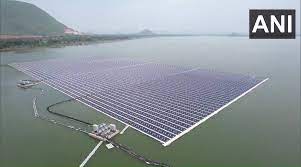Floating solar energy
Courtesy : www. nara solar .com
Floating solar energy is the one that uses stagnant water (such as irrigation water, lagoons, lakes, dams, etc.) for the installation of photovoltaic solar energy infrastructures. Unlike solar panels located on land, these are mounted or installed on platforms that float on the water, interconnected with walkways that form maintenance corridors.
Did you know that one of the largest floating solar power plants is located on a reservoir in South Korea? That’s right, more than 92,000 floating solar panels shaped like plum blossoms float on a South Korean reservoir, more than 12 miles long in the southern county of Hapcheon. This installation is capable of generating 41 megawatts and powering 20,000 homes.
Some of the advantages of floating solar power plants are as follows:
Minimal land consumption: solar power plants, as they are built on water, do not require occupied land space. These installations are characterised by the fact that they are installed on sheets of water that do not interfere with their use, such as water treatment plants, water reservoirs such as reservoirs, hydroelectric dams or irrigation ponds.
Increased efficiency: the performance of floating solar panels is much higher as the water on which they are installed produces a cooling effect, which reduces the ambient temperature and increases humidity, improving efficiency by 10-15%.
Reduced maintenance: these panels do not require frequent cleaning. The amount of dust on the surface of the water is less compared to dust on the ground.
They reduce water evaporation: the floating solar panels, by covering a large part of the water surface where they are located, manage to reduce evaporation by 85%, which allows greater use and performance of the reservoir.





